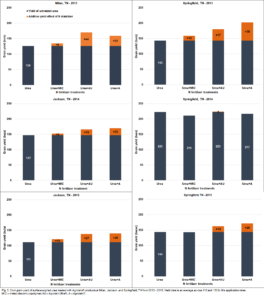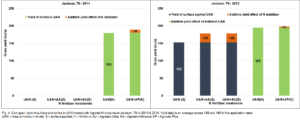Nitrogen (N) fertilization is a costly operation for most row crop producers. Consequently, it is important to implement best management practices (BMP) available for N fertilizer application in order to be profitable. The problem with N fertilizers is their potential to be lost through different N loss pathways: ammonia volatilization, denitrification, and leaching. Spring of 2020 has been generally wet and if this weather pattern continues, farmers should have no problem receiving incorporating rain, minimizing risk for ammonia volatilization from surface-applied at planting N. In TN, most row crop producers split-apply N, with the majority of N fertilizer applied as a sidedress which is closer to the period of high N demand. Since a large portion of N is applied as sidedress, there is the greatest risk for N loss depending on management practice as well as soil and environmental conditions. Continued wet weather might support the use of nitrification inhibitor type products in wetter soils. This blog addresses N stabilizers as a tool to minimize the risk of N loss and ensure that N is available for crops during the period of high demand.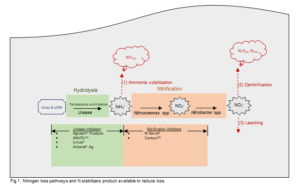
N stabilizers are chemicals added or used to treat N fertilizers, particularly urea-based fertilizers to control ammonia volatilization and nitrification processes largely responsible for N loss. When urea-based N fertilizers are applied to the soil, urease enzymes breakdown urea into ammonium under favorable soil moisture and temperature conditions. The conversion of ammonium into ammonia gas which escapes to the atmosphere is called ammonia volatilization. Nitrification is a two-step microbial process in which ammonia-oxidizing bacteria (Nitrosomonas spp.) catalyzes the conversion of ammonia into nitrite and then nitrite-oxidizing bacteria (Nitrobacter spp.) converts the nitrite to nitrate (Fig. 1). Nitrate may leach easily down the soil in highly permeable soils or may be converted into nitrous oxide or dinitrogen gas if the soil is ponded continuously for at least two days. The gases produced by denitrification escape into the environment and reduce the amount of N available for plant use. There are two types of N stabilizers; urease inhibitors and nitrification inhibitors. Urease inhibitors temporarily delay ammonia volatilization by disrupting the function of the urease enzyme to bind and catalyze the breakdown of urea. On the other hand, nitrification inhibitors temporarily delay nitrification by affecting the number and function of Nitrosomons or Nitrobacter spp. It is economical to use N stabilizers when weather and soil conditions are conducive for N loss. Urease inhibitors are recommended if incorporating urea and UAN into the soil is not possible within a few days after application. Also, treating urea-based N fertilizers with a urease inhibitor is recommended when urea-based fertilizer is applied onto a soil that is saturated without standing water.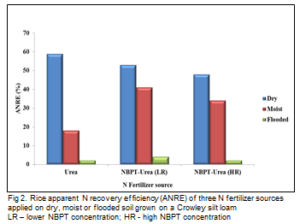
Urease inhibitors are not recommended for knifed-in UAN. Urea treated with urease inhibitors should not be applied into standing water. Studies conducted at the H. Rouse Caffey Rice Research Station suggest that a urease inhibitor will not offer any protection against N loss when the treated urea is applied into floodwater. Although drilled seeded delayed rice production system is one of the most efficient user of N fertilizers compared to most cropping systems, the efficiency of treated urea applied into the flood in this system was less than 10% (Fig. 2). Nitrification inhibitors are recommended when UAN or anhydrous ammonia is applied to fields that may remain wet for an extended period of time and in poorly drained fields that are prone to ponding or flooding for consecutive days after rainfall.
Unbiased field studies have been conducted in Tennessee to assess the performance of some of these N stabilizer products on urea and UAN N fertilizers under our growing conditions. Details on these field trials are available at https://extension.tennessee.edu/publications/Documents/W364.pdf
and https://www.nature.com/articles/s41598-019-42912-5. Dr. Savoy and other UT scientists evaluated the effect of urea treated with several urease inhibitors on corn yield. Results from 2013 – 2015 are reported in Fig. 3. Urea fertilizers treated with urease inhibitors containing NBPT increased grain yield by 0 – 59 bu/a compared to the untreated urea.
Dr. Yin, UT’s System Agronomist, examined the addition of Agrotain® products to UAN on corn yields in 2014 and 2015 (Fig. 4). Corn yield for surface applied UAN treated with N stabilizers was 25 bu/acre higher when compared with untreated UAN surface applied in 2015.
Most proven urease inhibitors products on the market contain only one active ingredient, NBPT. However, some of these products such as ANVOLTM and LimusTM contain other active ingredients in addition to NBPT. A product such as Agrotain Plus contains both urease (NBPT) and nitrification inhibitors (DCD). Products with known efficacy for inhibiting urease activity through unbiased laboratory and field research conducted by specialists in TN and neighboring states are provided in Table 1. Since the patent on NBPT has expired, a number of generic products are available on the market which contains NBPT, but at varying concentrations. If a product is not listed in Table 1, the University of Tennessee either has no research experience with the product or we have found the product to be ineffective in our research studies. Producers who decide to use these generic products should pay close attention to the concentrations of the active ingredient or the formulation and if possible consult with their extension agents prior to use.
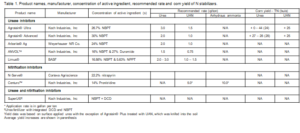 In conclusion, it is extremely important that producers make plans to control N loss because of potential yield loss and environmental implications. Since the benefit of N stabilizers are only actualized when conditions for N loss are conducive, producers may want to at least factor-in weather consideration when deciding on the type of N stabilizers to use. Producers should consider products that will provide the most benefit in regard to reducing N loss based on projected weather conditions at the time of fertilizer application through the periods of peak N uptake by the plant. It’s been a wet Spring so far and if this weather pattern continues, the most appropriate N loss to guard against will be denitrification. Including nitrification inhibitor in N management practice may provide insurance and provide protection against N and yield loss.
In conclusion, it is extremely important that producers make plans to control N loss because of potential yield loss and environmental implications. Since the benefit of N stabilizers are only actualized when conditions for N loss are conducive, producers may want to at least factor-in weather consideration when deciding on the type of N stabilizers to use. Producers should consider products that will provide the most benefit in regard to reducing N loss based on projected weather conditions at the time of fertilizer application through the periods of peak N uptake by the plant. It’s been a wet Spring so far and if this weather pattern continues, the most appropriate N loss to guard against will be denitrification. Including nitrification inhibitor in N management practice may provide insurance and provide protection against N and yield loss.

